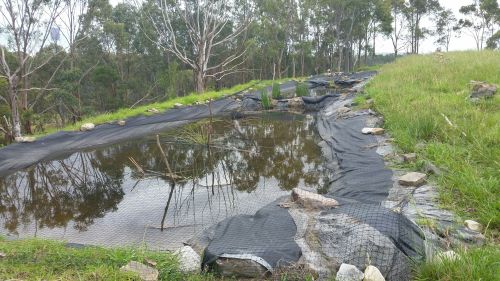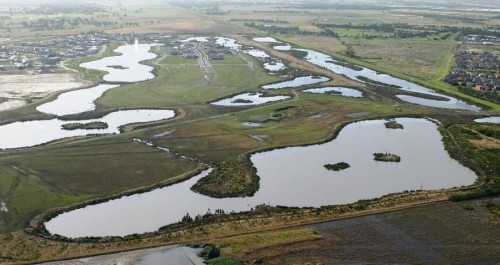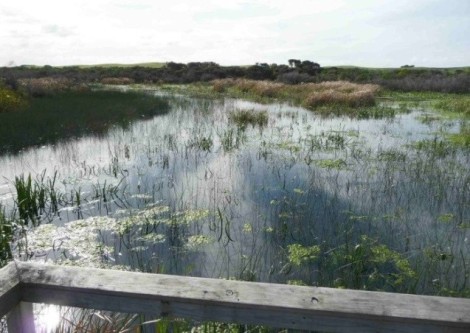Anne Jensen
[Update to EMR feature – Jensen, Anne (2002) Repairing wetlands of the Lower Murray: Learning from restoration practice. Ecological Management & Restoration, 3:1, 5-14. https://onlinelibrary.wiley.com/doi/10.1046/j.1442-8903.2002.00092.x]
Key words: Environmental water requirements, regeneration, wetlands, black box seedlings, Lower Murray Valley

Figure 1. Location of the Lower Murray Valley in South Australia (Map A. Jensen)
Introduction. As highlighted in the original EMR feature this summary is updating, in the Lower Murray Valley 1100 wetlands have been identified in 250 hydrologically-linked complexes (Fig. 1). They have undergone major changes to their water regime over the last 100 years, altering the timing, frequency and duration of floods. Wetlands at lower elevations have become permanently flooded by stable river levels and wetlands at higher elevations are ‘droughted’ by much reduced flooding. All would benefit from environmental watering, to fill gaps in breeding and regeneration cycles.
Our 2002 feature showed that, from 1998 to 2002, the not-for-profit conservation company Wetland Care Australia coordinated on-ground projects to repair priority wetlands in the Lower Murray. The Gurra Gurra project was the largest of these projects, with engineering works at 17 sites to restore multiple flowpaths through the 3000 ha floodplain complex.
Key funding from the National Heritage Trust terminated in 2002 and Wetland Care Australia relocated in 2003 to northern New South Wales, where project funding for wetland projects was still available. However, individuals involved with the Wetland Care Australia projects remained in the Lower Murray Valley in other jobs, so the intellectual property was retained and wetland conservation activities continued.
In 2002, the extent and severity of drought conditions in the Murray River Valley were just being recognised. By 2004, a survey estimated that >75% of the two main tree dominants in floodplain woodlands – River Red Gum (Eucalyptus camaldulensis) and Black Box (E. largiflorens) – were dead, dying or extremely stressed along 700 km of the Murray River Valley . The Millenium Drought (2000-2010) caused extreme stress to both ecological and human communities. Government agencies commenced emergency environmental watering from 2004 through the Living Murray program to limit catastrophic damage at eight iconic sites but millions of mature eucalypts were lost from floodplain woodlands along river valleys.
The Millenium Drought changed the governance context radically, with the Water Act 2007 establishing a new Murray-Darling Basin Authority and the Basin Plan. The Commonwealth Environmental Water Holder (CEWH) was able to purchase water for environmental use.
Nature delivered life-saving floods in 2010-12, which broke the drought and sent flows through the Gurra Gurra complex flowpaths, so the works completed back in 2000 finally fulfilled their function (Fig. 2). Water flowed through the pipes at Tortoise Crossing for 170 days in 2010-11 and again for 71 days in 2012.

Figure 2. The sign at the key Tortoise Crossing flow path explains that replacing three pipes with 160 pipes back in 2000 now allows 50 times more flow when the river floods, as seen at the flood peak in December 2016 (Photos A. Jensen)
The sequence of floods led to mass germination of Black Box at medium floodplain elevations, with mass River Red Gum seedlings at lower elevations. A range of studies show that the survival of these seedlings is critical to fill age gaps and replace the losses from the Millenium Drought, as survival rates from germination events in the 1970s and 1990s were very poor and the last successful mass recruitment of Black Box in the Lower Murray Valley was from the 1955-56 floods.
Following the floods in 2010-2012, conditions were dry in 2013-15 and the fields of mass seedlings began to dry out and die. A further short flood in 2016 watered the surviving fields of Black Box seedlings for at least two weeks, adding to prospects of survival and flowing through the Tortoise Crossing pipes for 75 days. However, conditions in 2018-19 and into summer 2019-20 are once again extremely dry, with stress appearing in mature trees and saplings dying off. The Lower Murray Valley is still recovering from the Millenium Drought, thus needing more frequent watering over a sequence of years to bring mature trees back to health and full seed production, so this is a significant setback.
Further works and activities since 2002. Since 2008, the environmental charity Nature Foundation SA (NFSA) has been undertaking environmental watering projects on smaller, privately-owned sites in the Lower Murray, many from the original Wetland Care Australia list. In the Lower Murray Valley, water needs to be lifted up to 3 m from the river channel to reach wetlands on the floodplain, requiring costly energy. This is done using irrigation techniques, including pumps, pipes and sprinklers. These smaller projects complement government agency projects using major infrastructure to deliver environmental water to much larger wetland complexes.
In 2008-09, the primary purpose was to acquire water and use it to limit extreme environmental damage in the drought. In 2009 NFSA provided supplementary water for Little Duck Lagoon, one of the sites from the Wetland Care Australia Gurra Gurra project.
From 2012-19, NFSA has held a contract partnered with the Commonwealth Environmental Water Holder (CEWH) to deliver up to 10 GL/y of environmental water to selected sites. A priority for the NFSA Water for Nature program has been to sustain the mass germination triggered by the 2010-12 floods, watering fields of seedlings and saplings so they can fill the very large gap in age structure of Black Box populations. Stressed mature Black Box trees are being watered to improve their condition and volumes of seed produced. While delivering water to a defined wetland is relatively simple, with water pumped to an inlet point and allowed to pool in the wetland, watering scattered fields of seedlings and saplings on relatively flat floodplain land is a challenge, especially when they are in gaps between mature trees. The solution has been to use high-throw sprinklers (simulating rainfall) and operating them at night, to allow soakage into clay soils and to avoid evaporative loss during the day.
Since 2008, NFSA has delivered almost 13 GL of water to 97 watering sites in 20 wetland complexes, covering 27 different ecological targets across 12 habitat types. A total of 4.9 GL was delivered to 15 sites in 2017-18 and 1.55 GL was delivered in 2018-19 to 25 sites covering 126 ha. Rolling 5-year watering plans have been developed for each site, able to respond to annual water availability, Basin-wide priorities, environmental water requirements, climatic conditions, site watering history and feasibility of delivery.
One of the NFSA sites is Lyrup Lagoon in the Gurra Gurra complex, being watered to reduce accumulated salinity from groundwater inflows. Importantly, the infrastructure of the Central Irrigation Trust was used to deliver water to the lagoon. Thus, local irrigators are partners in delivery of water for regional environmental benefits and river health.

Figure 3. Watering guidelines developed by the Water For Nature program for stressed and healthy woodlands, for (a) River Red Gum and (b) Black Box (Water for Nature).
Further Results. The initial watering guidelines reported in the original EMR feature have been expanded through research and monitoring of responses to watering events, developing guidelines for timing and frequency of wetting and drying cycles to promote recovery in mature trees and support germination and survival of seedlings. These have been applied for each site in the rolling 5-year watering plans, which then determine the annual list of sites due for watering (see NFSA 5 year strategy and Fig. 3).
Watering by NFSA 2013-2019 has sustained Black Box seedlings and saplings through four dry summers, with watered plants 2-3 times taller than non-watered plants (Fig. 4). The Water For Nature monitoring report shows that, at NFSA sites, mature Black Box trees that have received periodic environmental water as determined by their 5-year watering plan during 2015-2019 were 21-46% (average 36%) better in health than adjacent non-watered sites, with denser, more vigorous canopies and the relative improvement was greatest during hotter and drier periods. The watering events thus provided water between natural floods to sustain growth in saplings and crop cycles in mature trees. Watering at other NFSA sites has provided vital habitat for vulnerable and endangered fauna including the Murray Hardyhead (Craterocephalus fluviatilis), Southern Bell Frog (Litoria raniformis), Regent Parrot (Polytelis anthopeplus) and Latham’s Snipe (Gallinago hardwickii).


Figure 4. Watered River Red Gum saplings at Thiele Flat, Loxton; November 2013 (top) and March 2018 (bottom). Note 2016 flood level mark on foreground trees (Photos A. Jensen)
Lessons learned and future directions. The significant benefits of environmental water have been demonstrated at NFSA’s Water For Nature sites, for floodplain vegetation communities and in temporary wetlands. Evolving research indicates that watering in late spring-early summer mimics peak flows in the natural water regime, coinciding with highest chances of breeding and germination events and thus ecologically ideal timing (See bibliography). Benefits are increased if seasonally filled wetlands are topped up in early summer, to ensure sufficient duration to sustain frog and waterbird breeding.
As well as ideal timing, studies have shown that watering at any time of the year can be beneficial, including enhancing soil moisture storage in the unsaturated zone and sustaining volume in bud and fruit crops. A key finding has been that watering in late autumn-early winter sustains soil moisture, priming sites to give an enhanced response to watering in the following spring-summer.
However, dry climatic conditions and political pressures to minimise water recovery volumes are combining to reduce availability of environmental water, with only very highest priority sites likely to receive water in the 2019-20 water year. Environmental water cannot create floods, it can only provide water to selected priority sites during dry times and enhance the benefits of any natural floods. Current volumes can only meet the requirements of a limited number of sites, leaving many sites without the water needed to sustain them through dry times or to recover from the severe impact of the Millenium drought.
Bureaucratic processes for approvals also hinder effective delivery of environmental water. With the water year coinciding with the financial year from July to June, water delivery stops in June to allow water accounts to be finalised. Approval to water in the following year can take 2-3 months, meaning no water can be delivered during the winter months for priming, missing the advantage of low evaporation rates and higher chances of piggy-backing on rainfall events.
Funding for environmental projects tends to be short term, leading to job insecurity for project managers, loss of continuity and project knowledge, and inability to complete watering sequences. Very significant volunteer resources are required to make these watering projects happen, including inputs from landholders who have donated electricity connections to the floodplain, transported diesel to re-fuel pumps, loaned pumps, tractors and irrigation equipment, plus use of irrigation and local government infrastructure to deliver water, and physical assistance and maintenance from local volunteer groups.
Practical on-ground watering knowledge is maturing well; what is needed now is sufficient water and ongoing consistent funding to support projects to deliver minimum environmental water requirements for the wetlands of the Lower Murray Valley. The pipes at Tortoise Crossing, installed in 2000 and only flooded twice, are more than ready for the next high flows to pour through!
Stakeholders and Funding bodies. The monitoring project was supported as part of the project Ecological Responses to Environmental Watering in the South Australian River Murray Valley, assessing the benefits of salinity interception schemes on floodplain vegetation, coordinated by Australian Water Environments for SA Water from March 2015 to June 2017. Continuing funding for monitoring in 2017-2019 was provided in a grant from the Ian Potter Foundation to Nature Foundation SA, as well as funding from the Commonwealth Environmental Water Holder (2018-19). Water for the environmental watering projects studied here was provided through annual allocations of water from the Commonwealth Environmental Water Office to Nature Foundation SA. Water delivery was managed by the NFSA Water For Nature program through Program Manager Natalie Stalenberg. Practical support and site access was provided by Steve Clark, landholder and committee member for Water for Nature program, and landholders John and Bronwyn Burford.
Contact. Dr Anne Jensen, Environmental Consultant; Volunteer member, Water for Nature Committee, Nature Foundation SA; part-time consultant Wetland Ecologist for Water for Nature Program of Nature Foundation SA (7 Ford Street, Maylands SA 5069, Australia; Tel: +61 407 170 706; Email: ajensen@internode.on.net
















































